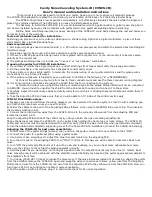
Technical Guide
Testing self-powered relays with SVERKER 900
Page 13(33)
Settings
Primary Settings
Secondary Test Current
Settings from the test circuits
(C-D)
Secondary Settings
(S2-S1)
I
>
I> = 30 A
Normal Inverse
(IEC “A”: Inverse)
Time Multiplier = 0,3
I>_test = 0,6 A
Normal Inverse
(IEC “A”: Inverse)
Time Multiplier = 0,3
I> = 0,156 A
Normal Inverse
(IEC “A”: Inverse)
Time Multiplier = 0,3
I>>
I>> = 200 A
Definite Time
Time Delay = 200 ms
I>>_test = 4,0 A
Definite Time
Time Delay = 200 ms
I>> = 1,042 A
Definite Time
Time Delay = 200 ms
Ano
ther practical method to follow, described in the relay manual, is that once the primary “base current” Is = 20
is selected with the dipswitches 1-1 to 1-4 (Figure 7), this table in par. 6.7.1 of the manual [5] informs that no
matter which current transformer is used, the base value of the “secondary test current” is 0,4 A (Figure 10).
Figure 10.
No matter which current transformer is used, the windings are arranged in such a way that the “base
current” (Is) has always the same “secondary test current” value (from the WIC-1 user’s manual [5], Copyright
SEG GmbH). The calculation of the relay thresholds in secondary test values is very much facilitated.
At this point all the other settings (chosen with other dipswitches, see Figure 7) are easy as they are
proportional to the value of the base current expressed from the test terminals:
I> = 1,5 x Is
I> = 1,5 x 0,4 A = 0,6 A
(secondary test currents)
I>> = 10 x Is
I>> = 10 x 0,4 A = 4 A
(secondary test currents)
5.2.2. Connecting SVERKER 900 to WIC-1 relay.
SVERKER 900 is connected to the protection relay according to Figure 11, where the three phase currents and
the operate (trip) contact are shown.














































